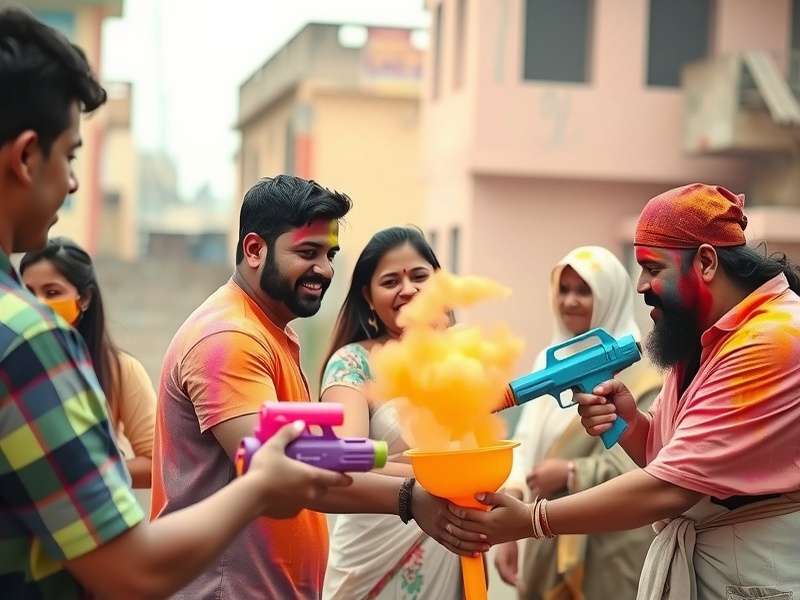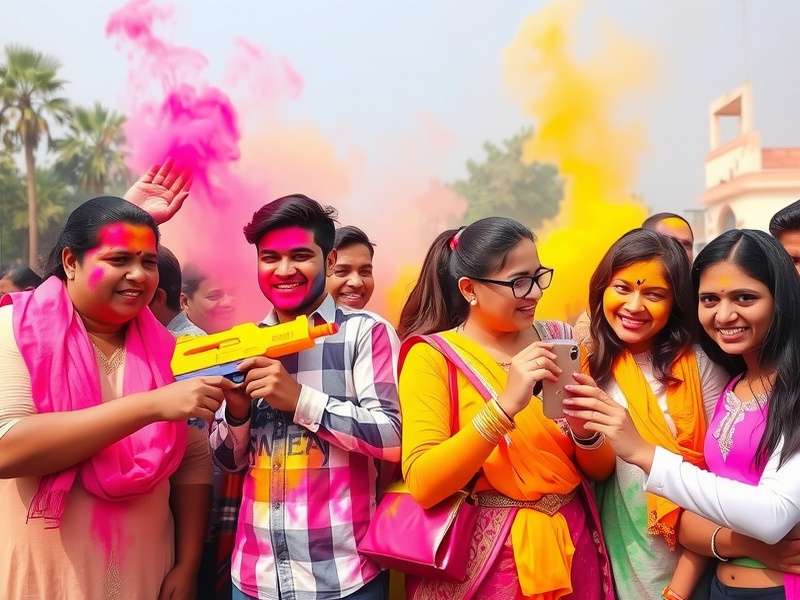Festival of Colors: The Complete Guide to Holi Celebrations
Discover the vibrant traditions, rich history, and cultural significance of India's most colorful festival
Table of Contents
Key Fact
The Festival of Colors, known as Holi, is celebrated on the full moon day in the Hindu month of Phalguna (February-March). It marks the arrival of spring and the victory of good over evil.
Overview of Festival of Colors
TheFestival of Colors, popularly known as Holi, is one of India's most vibrant and joyous celebrations. This ancient Hindu festival has transcended religious boundaries to become a global phenomenon celebrated by people of all backgrounds. TheFestival of Colorstypically occurs in March, corresponding with the arrival of spring, and is characterized by the playful throwing of colored powders and water.
At its core, theFestival of Colorsrepresents the triumph of good over evil, the arrival of spring, and a day when social norms are relaxed, and communities come together in a spirit of joy and reconciliation. The festival breaks down barriers of caste, class, age, and gender, creating an atmosphere of equality and universal brotherhood.
TheFestival of Colorsis not merely about throwing colors; it's a profound cultural expression that embodies the essence of Indian philosophy - the celebration of life, forgiveness, and new beginnings.
During theFestival of Colors, the air fills with excitement as people chase each other with dry powder and colored water. The streets transform into a vibrant canvas of reds, blues, greens, and yellows. Laughter echoes everywhere, traditional songs blare from speakers, and the scent of special festival foods permeates the atmosphere.

Historical Origins & Mythology
The origins of theFestival of Colorsare deeply rooted in Hindu mythology, with several legends explaining its significance. The most popular narrative involves the demon king Hiranyakashipu, his son Prahlada, and his sister Holika.
The Legend of Prahlada and Holika
According to Hindu scriptures, Hiranyakashipu was a powerful demon king who had received a boon making him nearly invincible. He grew arrogant and demanded that everyone worship him as god. However, his own son Prahlada remained devoted to Lord Vishnu. Enraged, Hiranyakashipu subjected Prahlada to various life-threatening punishments, but the boy survived each time through divine intervention.
The king's sister Holika possessed a special cloak that protected her from fire. Hiranyakashipu tricked Holika into sitting on a pyre with Prahlada on her lap, expecting the boy to burn while Holika remained safe. However, due to Prahlada's unwavering devotion, the cloak flew from Holika and covered him instead, saving his life while Holika perished in the flames.
"The burning of Holika is reenacted in Holika Dahan, symbolizing the victory of devotion over arrogance and the triumph of good over evil."
Other Mythological Connections
Another legend associates theFestival of Colorswith the divine love between Radha and Krishna. The young Krishna, who had dark blue skin, was jealous of Radha's fair complexion. His mother Yashoda playfully suggested he could color Radha's face to make her look like him. This evolved into the tradition of applying colors during the festival.
Some regional variations connect the festival to Kamadeva, the god of love, who sacrificed himself to revive Shiva from meditation. The festival thus also celebrates the rejuvenating power of love and desire.
Traditional Rituals & Practices
TheFestival of Colorsencompasses a rich tapestry of rituals that vary by region but share common themes of purification, celebration, and community bonding.
Holika Dahan: The Bonfire Night
The festivities begin on the night before the main day with Holika Dahan, where communities gather to light bonfires. These fires symbolize the burning of Holika and the destruction of evil. People perform religious rituals around the fire, sing traditional songs, and offer prayers. In some regions, people take embers from the fire to light their home hearths, symbolizing the carrying of prosperity into their households.
Playing with Colors: Rangwali Holi
The main day of celebration is known as Rangwali Holi or Dhulandi. This is when the famous color play occurs. People venture out into streets and open spaces armed with dry colored powder (gulal) and colored water (pichkaris). The atmosphere becomes carnival-like, with everyone fair game for being colored. Traditional colors were made from natural sources like turmeric, flowers, and vegetables, though synthetic colors have become more common today.

Festive Foods and Drinks
No Indian festival is complete without special culinary treats, and theFestival of Colorsis no exception. Traditional foods include gujiya (sweet dumplings), malpua (sweet pancakes), and thandai (a cooling milk-based drink often infused with cannabis in some regions). These foods are shared among family, friends, and neighbors, strengthening social bonds.
Musical and Dance Traditions
Music and dance form an integral part of Holi celebrations. Traditional folk songs called Holi geet are sung, often with provocative or humorous lyrics that would be considered inappropriate at other times. The breaking of social norms through music and playful teasing is a distinctive feature of the festival.
Modern Celebration & Events
While rooted in ancient traditions, theFestival of Colorshas evolved to accommodate contemporary lifestyles while preserving its core essence.
Urban Celebrations
In cities across India and around the world, organized Holi events have become increasingly popular. These often feature DJs, live music, dance performances, and massive color throws at designated times. Such events make the festival accessible to people who may not have community-based celebrations and have contributed to its global popularity.
Environmental Considerations
With growing environmental awareness, there has been a movement toward using natural, biodegradable colors instead of synthetic ones that can harm skin and the environment. Many communities now promote "eco-friendly Holi" with colors made from flowers, herbs, and vegetables.
The shift toward natural colors represents a modern reinterpretation of traditional practices, aligning ancient celebrations with contemporary ecological values.
Safety Measures
As public celebrations have grown, so have concerns about safety. Many organizers now implement measures such as separate areas for different age groups, security personnel, medical facilities, and clear guidelines for respectful participation. These measures help maintain the joyful spirit of the festival while ensuring everyone's wellbeing.
Commercial Aspects
The commercialization of Holi has led to specialized products ranging from organic colors to designer white outfits meant specifically for the color play. Brands often launch Holi-specific marketing campaigns, and the festival has become a significant economic event for many businesses.
Cultural & Social Significance
TheFestival of Colorsholds profound cultural and social significance that extends far beyond its visual spectacle.
Social Harmony and Equality
Holi is perhaps unique in its ability to temporarily dissolve social hierarchies. The throwing of colors makes everyone look similar, breaking down distinctions of class, caste, age, and gender. During the festival, traditional social norms are relaxed, and people interact with a freedom uncommon in daily life.
Psychological and Emotional Benefits
The festival serves as a collective catharsis, allowing people to release pent-up emotions and social tensions. The playful atmosphere encourages laughter, forgiveness, and the mending of strained relationships. Many people use the occasion to resolve conflicts and start anew.
"Holi is the day when we remember that beneath our different exteriors, we share a common humanity. The colors remind us that diversity makes life beautiful."
Agricultural Significance
As a spring festival, Holi coincides with the Rabi crop harvest. The celebration thus also functions as a harvest festival in many agricultural communities. The bonfires are sometimes seen as having purifying qualities that benefit the coming harvest season.

Cultural Preservation
Through its rituals, foods, music, and stories, theFestival of Colorsserves as a vehicle for transmitting cultural knowledge across generations. The preparation for the festival often involves family activities that reinforce cultural identity and continuity.
Global Impact & Adaptations
The appeal of theFestival of Colorshas transcended its Indian origins to become a global phenomenon celebrated across continents.
International Adoption
Holi celebrations now occur in numerous countries including the United States, United Kingdom, Australia, and various European and Asian nations. These international events are often organized by Indian diaspora communities but increasingly attract participation from diverse cultural backgrounds.
Commercial Color Runs
The concept of color throws has been commercialized in events like The Color Run, which describes itself as the "happiest 5K on the planet." While these events lack the religious and cultural context of Holi, they demonstrate the global appeal of color-based celebrations.
Influence on Arts and Media
The visual spectacle of Holi has inspired numerous artistic representations in film, photography, and visual arts. Bollywood movies frequently feature elaborate Holi sequences that have become iconic in their own right, further spreading awareness of the festival.
The global spread of theFestival of Colorsrepresents both cultural exchange and adaptation, as different communities interpret and celebrate the festival according to their local contexts while respecting its origins.
Educational Value
Many schools and cultural institutions outside India now incorporate Holi into their multicultural education programs. These educational activities help foster cross-cultural understanding and appreciation for diversity from a young age.
Conclusion & Future Outlook
TheFestival of Colorsstands as a vibrant testament to India's rich cultural heritage while simultaneously evolving to meet contemporary needs and global contexts. Its enduring appeal lies in its unique combination of visual spectacle, social leveling, psychological release, and cultural continuity.
As the world becomes increasingly interconnected, festivals like Holi offer valuable opportunities for cross-cultural exchange and mutual understanding. The universal themes of joy, renewal, and human connection resonate across geographical and cultural boundaries.
Looking forward, theFestival of Colorswill likely continue to adapt while preserving its essential character. The growing emphasis on eco-friendly celebrations represents one such adaptation, aligning ancient traditions with modern environmental consciousness. Similarly, the festival's expansion beyond its traditional communities offers opportunities for intercultural dialogue and shared celebration.
Ultimately, theFestival of Colorsreminds us of our capacity for joy, our need for community, and the beauty that emerges when we embrace both our differences and our common humanity. As it continues to color lives around the world, Holi stands as a powerful symbol of resilience, adaptation, and the enduring human spirit.
Did You Know?
The word "Holi" originates from "Holika", and the festival marks the beginning of spring after a long winter, symbolically representing the victory of good over evil.